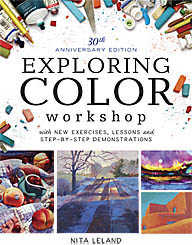How much water, how much paint?
We discussed paint quality in my watercolor class today. Not the quality of pigment, but the quality of the paint on the paper. This is usually what makes the difference between a professional-looking watercolor and a thinly painted or an overworked one. It takes a lot of practice to make masterful washes. You also need to know if you want your painting to be delicate or bold or somewhere between the two. The trick is to get the right consistency to your paint to get the effect you want from every brushstroke.
I read somewhere an analogy between paint consistency and milk products:
--Delicate washes are like skim milk--thin and runny.
--Add a little more paint for 2% consistency and slightly more intensity.
--More paint and less water make whole milk consistency on the palette and richer color.
--Still more paint, to the consistency of unwhipped cream, and you have intense paint mixtures.
You never want to get heavier than cream, though, or you'll lose too much transparency. Remember, if you're working wet-into-wet you need more paint on the palette because the water on the paper will dilute your paint somewhat.
I read somewhere an analogy between paint consistency and milk products:
--Delicate washes are like skim milk--thin and runny.
--Add a little more paint for 2% consistency and slightly more intensity.
--More paint and less water make whole milk consistency on the palette and richer color.
--Still more paint, to the consistency of unwhipped cream, and you have intense paint mixtures.
You never want to get heavier than cream, though, or you'll lose too much transparency. Remember, if you're working wet-into-wet you need more paint on the palette because the water on the paper will dilute your paint somewhat.
Labels: paint quality, tutorials, watercolor





0 Comments:
Post a Comment
<< Home